Study on the Positioning Accuracy of the GNSS/INS System Supported by the RTK Receiver for Railway Measurements
Abstract
:1. Introduction
2. Materials and Methods
2.1. Measurement Equipment
- The Ekinox2-U system enables operation in two modes:
- ⚬
- Post-Processing (PP)—post-processed data using Inertial Explorer (IE) with at least Precise Point Positioning (PPP) data;
- ⚬
- RTK—Real-Time Kinematics with a typical 1 cm accuracy position.
- The recording frequency for the data on angles, accelerations and position coordinates should be as high as possible. It is recommended that the IMU’s data should be recorded with a max frequency of 200 Hz.
2.2. Calibration and Configuration of the GNSS/INS System
2.3. Location of GNSS/INS Measurements
2.4. Realization of GNSS/INS Measurements
2.5. Processing of GNSS/INS Data
- Tight coupling Post-Processing Kinematic (PPK)—allows the highest GNSS/INS measurement accuracy to be obtained under conditions that are difficult in terms of satellite visibility. In order to be able to process GNSS/INS data using this method, it is necessary to have IMU data, raw GNSS data and the data from the GNSS geodetic network reference station;
- Loosely coupling—enables the determination of the IMU’s coordinates when no GNSS signal is available. In order to be able to process GNSS/INS data using this method, it is necessary to have IMU data and the data from the GNSS geodetic network reference station;
- PPK—allows the highest GNSS measurement accuracy to be obtained under conditions that are difficult in terms of satellite visibility. In order to be able to process GNSS data using this method, it is necessary to have raw GNSS data and the data from the GNSS geodetic network reference station.
- Section no. 1 (no terrain obstacles) was located on the railway line between the Radunia-Containers Ltd. in Gdynia and the Trasa Kwiatkowskiego (Figure 7a). Section no. 1 was approx. 2 km long. The measurement travel comprised long (several hundred metres), straight sections surrounded by virtually no terrain obstacles, the only exceptions being containers and bushes. The passage was performed on 9 June 2021 from 10:07:07 to 10:16:09 Coordinated Universal Time (UTC) (the duration of approx. 9 min).
- Section no. 2 (high building density) was located on the railway line between the Gdynia Główna railway station and the Gdańsk Osowa railway station (Figure 7b). Section no. 2 was approx. 15 km long. The measurement travel comprised circular curves with large turning angles. The second test section ran through numerous terrain obstacles, including multi-storey buildings and trees more than a dozen metres high. The passage was performed on 9 June 2021 from 08:35:03 to 09:05:50 UTC (the duration of approx. 31 min).
- Section no. 3 (no access to GNSS signal) was located on the railway line in a tunnel in the centre of Gdańsk between the Gdańsk Śródmieście railway station and the Gdańsk Główny railway station (Figure 7c). Section no. 3 was approx. 600 m long. The measurement travel comprised a long circular curve with a small turning angle under the tunnel, where no GNSS signal was received. Two passages were performed on 9 June 2021 from 06:41:47 to 06:43:02 UTC (the duration of 75 s) and from 11:58:47 to 11:59:55 UTC (the duration of 68 s).
3. Results
4. Discussion
5. Conclusions
Author Contributions
Funding
Institutional Review Board Statement
Informed Consent Statement
Data Availability Statement
Conflicts of Interest
References
- Koc, W.; Specht, C. Results of Satellite Measurements of Railway Track. TTS Rail Transp. Tech. 2009, 7, 58–64. (In Polish) [Google Scholar]
- Koc, W.; Specht, C.; Jurkowska, A.; Chrostowski, P.; Nowak, A.; Lewiński, L.; Bornowski, M. Determining the Course of the Railway Route by Means of Satellite Measurements. In Proceedings of the 2nd Scientific-Technical Conference, Design, Construction and Maintenance of Infrastructure in Rail Transport (INFRASZYN 2009), Zakopane, Poland, 22–24 April 2009. (In Polish). [Google Scholar]
- Specht, M.; Specht, C.; Wilk, A.; Koc, W.; Smolarek, L.; Czaplewski, K.; Karwowski, K.; Dąbrowski, P.S.; Skibicki, J.; Chrostowski, P.; et al. Testing the Positioning Accuracy of GNSS Solutions during the Tramway Track Mobile Satellite Measurements in Diverse Urban Signal Reception Conditions. Energies 2020, 13, 3646. [Google Scholar] [CrossRef]
- Specht, C.; Wilk, A.; Koc, W.; Karwowski, K.; Dąbrowski, P.; Specht, M.; Grulkowski, S.; Chrostowski, P.; Szmagliński, J.; Czaplewski, K.; et al. Verification of GNSS Measurements of the Railway Track Using Standard Techniques for Determining Coordinates. Remote Sens. 2020, 12, 2874. [Google Scholar] [CrossRef]
- Specht, M.; Specht, C.; Dąbrowski, P.; Czaplewski, K.; Smolarek, L.; Lewicka, O. Road Tests of the Positioning Accuracy of INS/GNSS Systems Based on MEMS Technology for Navigating Railway Vehicles. Energies 2020, 13, 4463. [Google Scholar] [CrossRef]
- Wilk, A.; Specht, C.; Koc, W.; Karwowski, K.; Skibicki, J.; Szmagliński, J.; Chrostowski, P.; Dabrowski, P.; Specht, M.; Zienkiewicz, M.; et al. Evaluation of the Possibility of Identifying a Complex Polygonal Tram Track Layout Using Multiple Satellite Measurements. Sensors 2020, 20, 4408. [Google Scholar] [CrossRef] [PubMed]
- Czaplewski, K.; Wisniewski, Z.; Specht, C.; Wilk, A.; Koc, W.; Karwowski, K.; Skibicki, J.; Dabrowski, P.; Czaplewski, B.; Specht, M.; et al. Application of Least Squares with Conditional Equations Method for Railway Track Inventory Using GNSS Observations. Sensors 2020, 20, 4948. [Google Scholar] [CrossRef] [PubMed]
- Koc, W.; Wilk, A.; Specht, C.; Karwowski, K.; Skibicki, J.; Czaplewski, K.; Judek, S.; Chrostowski, P.; Szmagliński, J.; Dąbrowski, P.; et al. Determining Horizontal Curvature of Railway Track Axis in Mobile Satellite Measurements. Bull. Pol. Acad. Sci. Tech. Sci. 2021, 69, e139204. [Google Scholar]
- Wilk, A.; Koc, W.; Specht, C.; Skibicki, J.D.; Judek, S.; Karwowski, K.; Chrostowski, P.; Szmaglinski, J.; Dabrowski, P.; Czaplewski, K.; et al. Innovative Mobile Method to Determine Railway Track Axis Position in Global Coordinate System Using Position Measurements Performed with GNSS and Fixed Base of the Measuring Vehicle. Measurement 2021, 175, 109016. [Google Scholar] [CrossRef]
- Wilk, A.; Koc, W.; Specht, C.; Judek, S.; Karwowski, K.; Chrostowski, P.; Czaplewski, K.; Dabrowski, P.S.; Grulkowski, S.; Licow, R.; et al. Digital Filtering of Railway Track Coordinates in Mobile Multi–receiver GNSS Measurements. Sensors 2020, 20, 5018. [Google Scholar] [CrossRef]
- Akpinar, B.; Gulal, E. Multisensor Railway Track Geometry Surveying System. IEEE Trans. Instrum. Meas. 2012, 61, 190–197. [Google Scholar] [CrossRef]
- Gao, Z.; Ge, M.; Li, Y.; Shen, W.; Zhang, H.; Schuh, H. Railway Irregularity Measuring Using Rauch–Tung–Striebel Smoothed Multi-sensors Fusion System: Quad-GNSS PPP, IMU, Odometer, and Track Gauge. GPS Solut. 2018, 22, 36. [Google Scholar] [CrossRef]
- Kurhan, M.B.; Kurhan, D.M.; Baidak, S.Y.; Khmelevska, N.P. Research of Railway Track Parameters in the Plan Based on the Different Methods of Survey. Nauka Prog. Transp. 2018, 2, 77–86. [Google Scholar] [CrossRef] [Green Version]
- Li, Q.; Chen, Z.; Hu, Q.; Zhang, L. Laser-aided INS and Odometer Navigation System for Subway Track Irregularity Measurement. J. Surv. Eng. 2017, 143, 04017014. [Google Scholar] [CrossRef]
- Zhou, Y.; Chen, Q.; Niu, Q. Kinematic Measurement of the Railway Track Centerline Position by GNSS/INS/Odometer Integration. IEEE Access 2019, 7, 157241–157253. [Google Scholar] [CrossRef]
- Specht, C.; Koc, W. Mobile Satellite Measurements in Designing and Exploitation of Rail Roads. Transp. Res. Procedia 2016, 14, 625–634. [Google Scholar] [CrossRef] [Green Version]
- Chen, Q.; Niu, X.; Zhang, Q.; Cheng, Y. Railway Track Irregularity Measuring by GNSS/INS Integration. Navig. J. Inst. Navig. 2015, 62, 83–93. [Google Scholar] [CrossRef]
- Li, R.; Bai, Z.; Chen, B.; Xin, H.; Cheng, Y.; Li, Q.; Wu, F. High-speed Railway Track Integrated Inspecting by GNSS-INS Multisensor. In Proceedings of the 2020 IEEE/ION Position, Location and Navigation Symposium (PLANS 2020), Portland, OR, USA, 20–23 April 2020. [Google Scholar]
- Zhang, Q.; Chen, Q.; Niu, X.; Shi, C. Requirement Assessment of the Relative Spatial Accuracy of a Motion-constrained GNSS/INS in Shortwave Track Irregularity Measurement. Sensors 2019, 19, 5296. [Google Scholar] [CrossRef] [Green Version]
- Zhang, X.; Cui, X.; Huang, B. The Design and Implementation of an Inertial GNSS Odometer Integrated Navigation System Based on a Federated Kalman Filter for High-speed Railway Track Inspection. Appl. Sci. 2021, 11, 5244. [Google Scholar] [CrossRef]
- Reimer, C.; Müller, F.J.; Hinüber, E.L.V. INS/GNSS/Odometer Data Fusion in Railway Applications. In Proceedings of the 2016 DGON Intertial Sensors and Systems (ISS 2016), Karlsruhe, Germany, 20–21 September 2016. [Google Scholar]
- Bedkowski, J.; Nowak, H.; Kubiak, B.; Studzinski, W.; Janeczek, M.; Karas, S.; Kopaczewski, A.; Makosiej, P.; Koszuk, J.; Pec, M.; et al. A Novel Approach to Global Positioning System Accuracy Assessment, Verified on LiDAR Alignment of One Million Kilometers at a Continent Scale, as a Foundation for Autonomous DRIVING Safety Analysis. Sensors 2021, 21, 5691. [Google Scholar] [CrossRef]
- Elsheikh, M.; Abdelfatah, W.; Noureldin, A.; Iqbal, U.; Korenberg, M. Low-cost Real-time PPP/INS Integration for Automated Land Vehicles. Sensors 2019, 19, 4896. [Google Scholar] [CrossRef] [Green Version]
- Zhu, F.; Shen, Y.; Wang, Y.; Jia, J.; Zhang, X. Fusing GNSS/INS/Vision with a Priori Feature Map for High-precision and Continuous Navigation. IEEE Sens. J. 2021, 21, 23370–23381. [Google Scholar] [CrossRef]
- Brazeal, R.G.; Wilkinson, B.E.; Benjamin, A.R. Investigating Practical Impacts of Using Single-antenna and Dual-antenna GNSS/INS Sensors in UAS-Lidar Applications. Sensors 2021, 21, 5382. [Google Scholar] [CrossRef] [PubMed]
- Mwenegoha, H.A.; Moore, T.; Pinchin, J.; Jabbal, M. A Model-based Tightly Coupled Architecture for Low-cost Unmanned Aerial Vehicles for Real-time Applications. IEEE Access 2020, 1–20. [Google Scholar] [CrossRef]
- Naus, K.; Szymak, P.; Piskur, P.; Niedziela, M.; Nowak, A. Methodology for the Correction of the Spatial Orientation Angles of the Unmanned Aerial Vehicle Using Real Time GNSS, a Shoreline Image and an Electronic Navigational Chart. Energies 2021, 14, 2810. [Google Scholar] [CrossRef]
- Wang, Q.; Cui, X.; Li, Y.; Ye, F. Performance Enhancement of a USV INS/CNS/DVL Integration Navigation System Based on an Adaptive Information Sharing Factor Federated Filter. Sensors 2017, 17, 239. [Google Scholar] [CrossRef] [Green Version]
- Xia, G.; Wang, G. INS/GNSS Tightly-coupled Integration Using Quaternion-based AUPF for USV. Sensors 2016, 16, 1215. [Google Scholar] [CrossRef] [Green Version]
- Yan, W.; Zhang, Q.; Zhang, Y.; Wang, A.; Zhao, C. The Validation and Performance Assessment of the Android Smartphone Based GNSS/INS Coupled Navigation System. In Proceedings of the 12th China Satellite Navigation Conference (CSNC 2021), Nanchang, China, 22–25 May 2021. [Google Scholar]
- Li, N.; Guan, L.; Gao, Y.; Du, S.; Wu, M.; Guang, X.; Cong, X. Indoor and Outdoor Low-cost Seamless Integrated Navigation System Based on the Integration of INS/GNSS/LIDAR System. Remote Sens. 2020, 12, 3271. [Google Scholar] [CrossRef]
- Zhuang, Y.; Lan, H.; Li, Y.; El-Sheimy, N. PDR/INS/WiFi Integration Based on Handheld Devices for Indoor Pedestrian Navigation. Micromachines 2015, 6, 793–812. [Google Scholar] [CrossRef] [Green Version]
- Jing, S.; Zhan, X.; Liu, B.; Chen, M. Weak and Dynamic GNSS Signal Tracking Strategies for Flight Missions in the Space Service Volume. Sensors 2016, 16, 1412. [Google Scholar] [CrossRef] [Green Version]
- Barzaghi, R.; Carrion, D.; Pepe, M.; Prezioso, G. Computing the Deflection of the Vertical for Improving Aerial Surveys: A Comparison between EGM2008 and ITALGEO05 Estimates. Sensors 2016, 16, 1168. [Google Scholar] [CrossRef] [Green Version]
- Pytka, J.; Budzyński, P.; Józwik, J.; Michałowska, J.; Tofil, A.; Łyszczyk, T.; Błażejczak, D. Application of GNSS/INS and an Optical Sensor for Determining Airplane Takeoff and Landing Performance on a Grassy Airfield. Sensors 2019, 19, 5492. [Google Scholar] [CrossRef] [PubMed] [Green Version]
- Qian, C.; Liu, H.; Tang, J.; Chen, Y.; Kaartinen, H.; Kukko, A.; Zhu, L.; Liang, X.; Chen, L.; Hyyppä, J. An Integrated GNSS/INS/LiDAR-SLAM Positioning Method for Highly Accurate Forest Stem Mapping. Remote Sens. 2017, 9, 3. [Google Scholar] [CrossRef] [Green Version]
- El-Diasty, M. Development of Real-time PPP-based GPS/INS Integration System Using IGS Real-time Service for Hydrographic Surveys. J. Surv. Eng. 2016, 142, 1–8. [Google Scholar] [CrossRef]
- El-Diasty, M. Evaluation of KSACORS-based Network GNSS-INS Integrated System for Saudi Coastal Hydrographic Surveys. Geomat. Nat. Hazards Risk 2020, 11, 1426–1446. [Google Scholar] [CrossRef]
- Scheider, A.; Wirth, H.; Breitenfeld, M.; Schwieger, V. HydrOs—An Integrated Hydrographic Positioning System for Surveying Vessels. In Proceedings of the XXV FIG Congress 2014, Kuala Lumpur, Malaysia, 16–21 June 2014. [Google Scholar]
- Sun, Z.; Tang, K.; Wang, X.; Wu, M.; Guo, Y. High-speed Train Tunnel Navigation Method Based on Integrated MIMU/ODO/MC Navigation. Appl. Sci. 2021, 11, 3680. [Google Scholar] [CrossRef]
- Sun, Z.; Tang, K.; Wu, M.; Guo, Y.; Wang, X. High-speed Train Positioning Method Based on Motion Constraints Suppressing INS Error in Tunnel. J. Northwest. Polytech. Univ. 2021, 39, 624–632. [Google Scholar] [CrossRef]
- Chen, K.; Chang, G.; Chen, C. GINav: A MATLAB-based Software for the Data Processing and Analysis of a GNSS/INS Integrated Navigation System. GPS Solut. 2021, 25, 108. [Google Scholar] [CrossRef]
- Du, S.; Zhang, S.; Gan, X. A Hybrid Fusion Strategy for the Land Vehicle Navigation Using MEMS INS, Odometer and GNSS. IEEE Access 2020, 8, 152512–152522. [Google Scholar] [CrossRef]
- Elmezayen, A.; El-Rabbany, A. Ultra-low-cost Tightly Coupled Triple-constellation GNSS PPP/MEMS-based INS Integration for Land Vehicular Applications. Geomatics 2021, 1, 258–286. [Google Scholar] [CrossRef]
- Dong, P.; Cheng, J.; Liu, L. A Novel Anti-jamming Technique for INS/GNSS Integration Based on Black Box Variational Inference. Appl. Sci. 2021, 11, 3664. [Google Scholar] [CrossRef]
- Kujur, B.; Khanafseh, S.; Pervan, B. Detecting GNSS Spoofing of ADS-B Equipped Aircraft Using INS. In Proceedings of the 2020 IEEE/ION Position, Location and Navigation Symposium (PLANS 2020), Portland, OR, USA, 20–23 April 2020. [Google Scholar]
- Won, D.H.; Lee, E.; Heo, M.; Lee, S.-W.; Lee, J.; Kim, J.; Sung, S.; Jae, Y. Selective Integration of GNSS, Vision Sensor, and INS Using Weighted DOP Under GNSS-challenged Environments. IEEE Trans. Instrum. Meas. 2014, 63, 2288–2298. [Google Scholar] [CrossRef]
- Yang, L.; Li, Y.; Wu, Y.; Rizos, C. An Enhanced MEMS-INS/GNSS Integrated System with Fault Detection and Exclusion Capability for Land Vehicle Navigation in Urban Areas. GPS Solut. 2014, 18, 593–603. [Google Scholar] [CrossRef]
- Zhang, Z. Code and Phase Multipath Mitigation by Using the Observation-domain Parameterization and its Application in Five-frequency GNSS Ambiguity Resolution. GPS Solut. 2021, 25, 144. [Google Scholar] [CrossRef]
- Specht, C.; Specht, M.; Dąbrowski, P. Comparative Analysis of Active Geodetic Networks in Poland. In Proceedings of the 17th International Multidisciplinary Scientific GeoConference (SGEM 2017), Albena, Bulgaria, 27 June–6 July 2017. [Google Scholar]
- Mora, O.E.; Langford, M.; Mislang, R.; Josenhans, R.; Jorge Chen, J. Precision Performance Evaluation of RTK and RTN Solutions: A Case Study. J. Spat. Sci. 2020, 1–14. [Google Scholar] [CrossRef]
- Gargula, T. Adjustment of an Integrated Geodetic Network Composed of GNSS Vectors and Classical Terrestrial Linear Pseudo-observations. Appl. Sci. 2021, 11, 4352. [Google Scholar] [CrossRef]
- Walwer, D.; Calais, E.; Ghil, M. Data-adaptive Detection of Transient Deformation in Geodetic Networks. J. Geophys. Res. Solid Earth 2016, 121, 2129–2152. [Google Scholar] [CrossRef] [Green Version]
- Makar, A. Determination of Inland Areas Coastlines. In Proceedings of the 18th International Multidisciplinary Scientific GeoConference (SGEM 2018), Albena, Bulgaria, 2–8 July 2018. [Google Scholar]
- Makar, A. Dynamic Tests of ASG-EUPOS Receiver in Hydrographic Application. In Proceedings of the 18th International Multidisciplinary Scientific GeoConference (SGEM 2018), Albena, Bulgaria, 2–8 July 2018. [Google Scholar]
- Bousquet, O.; Lees, E.; Durand, J.; Peltier, A.; Duret, A.; Mekies, D.; Boissier, P.; Donal, T.; Fleischer-Dogley, F.; Zakariasy, L. Densification of the Ground-based GNSS Observation Network in the Southwest Indian Ocean: Current Status, Perspectives, and Examples of Applications in Meteorology and Geodesy. Front. Earth Sci. 2020, 8, 566105. [Google Scholar] [CrossRef]
- Krasuski, K.; Ciećko, A.; Bakuła, M.; Grunwald, G.; Wierzbicki, D. New Methodology of Designation the Precise Aircraft Position Based on the RTK GPS Solution. Sensors 2022, 22, 21. [Google Scholar] [CrossRef]
- Krasuski, K.; Mrozik, M.; Wierzbicki, D.; Ćwiklak, J.; Kozuba, J.; Ciećko, A. Designation of the Quality of EGNOS+SDCM Satellite Positioning in the Approach to Landing Procedure. Appl. Sci. 2022, 12, 1335. [Google Scholar] [CrossRef]
- Visconti, P.; Iaia, F.; De Fazio, R.; Giannoccaro, N.I. A Stake-out Prototype System Based on GNSS-RTK Technology for Implementing Accurate Vehicle Reliability and Performance Tests. Energies 2021, 14, 4885. [Google Scholar] [CrossRef]
- Bakuła, M. Study of Reliable Rapid and Ultrarapid Static GNSS Surveying for Determination of the Coordinates of Control Points in Obstructed Conditions. J. Surv. Eng. 2013, 139, 188–193. [Google Scholar] [CrossRef]
- Przestrzelski, P.; Bakuła, M. Performance of Real-time Network Code DGPS Services of ASG-EUPOS in North-eastern Poland. Tech. Sci. 2014, 17, 191–207. [Google Scholar]
- Bakuła, M.; Pelc-Mieczkowska, R.; Walawski, M. Reliable and Redundant RTK Positioning for Applications in Hard Observational Conditions. Artif. Satell. 2012, 47, 23–33. [Google Scholar] [CrossRef]
- Janos, D.; Kuras, P. Evaluation of Low-cost GNSS Receiver under Demanding Conditions in RTK Network Mode. Sensors 2021, 21, 5552. [Google Scholar] [CrossRef] [PubMed]
- SBG Systems. Ekinox Series. Available online: https://www.sbg-systems.com/products/ekinox-series/ (accessed on 25 April 2022).
- Stateczny, A.; Specht, C.; Specht, M.; Brčić, D.; Jugović, A.; Widźgowski, S.; Wiśniewska, M.; Lewicka, O. Study on the Positioning Accuracy of GNSS/INS Systems Supported by DGPS and RTK Receivers for Hydrographic Surveys. Energies 2021, 14, 7413. [Google Scholar] [CrossRef]
- SBG Systems. Qinertia. Available online: https://www.sbg-systems.com/products/qinertia-ins-gnss-post-processing-software/ (accessed on 25 April 2022).
- Gurtner, W.; Estey, L. RINEX: The Receiver Independent Exchange Format Version 2.11. Available online: https://files.igs.org/pub/data/format/rinex300.pdf (accessed on 25 April 2022).
- NovAtel. GPS Position Accuracy Measures. Available online: https://novatel.com/support/support-materials/application-notes (accessed on 25 April 2022).


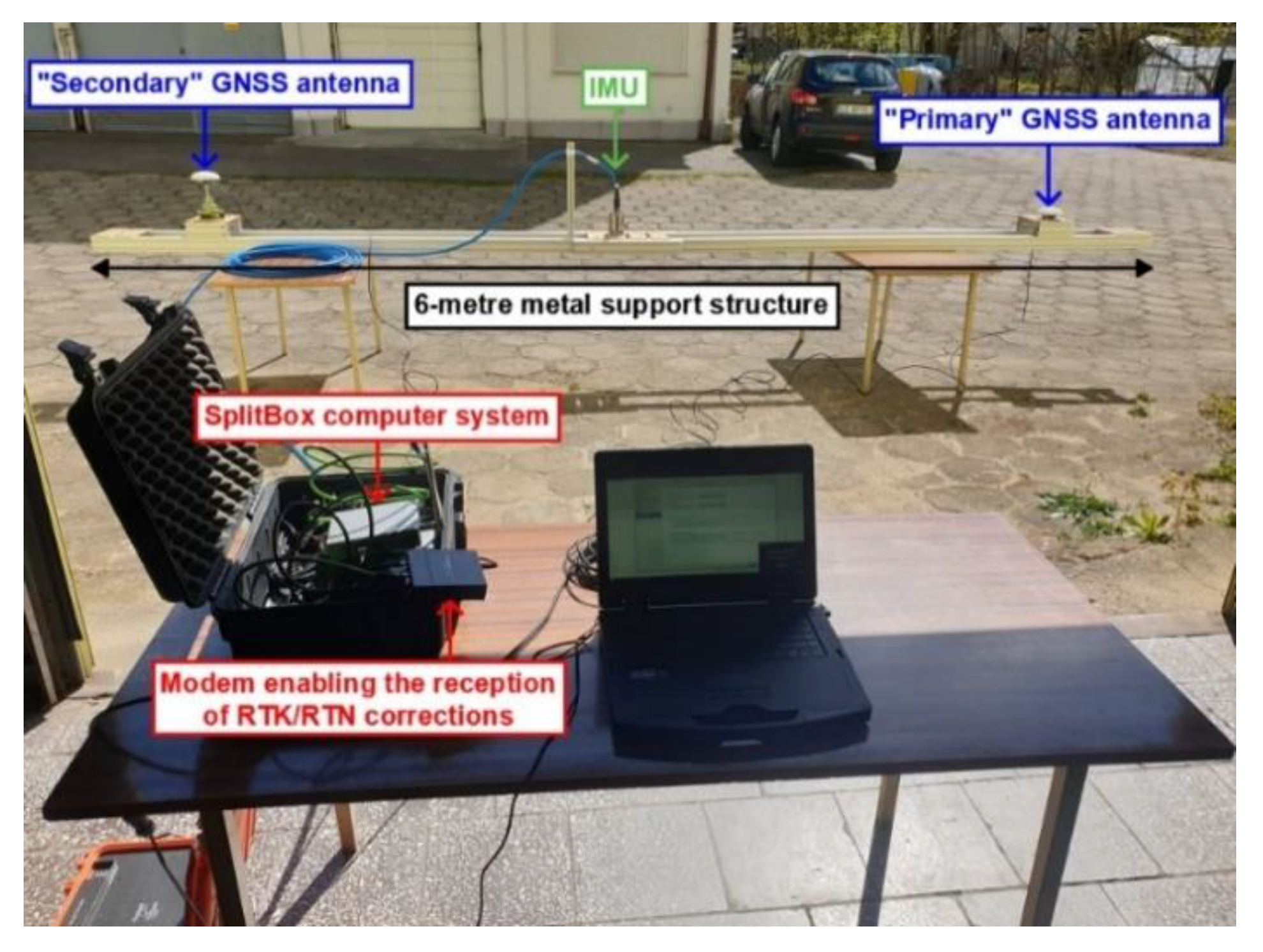




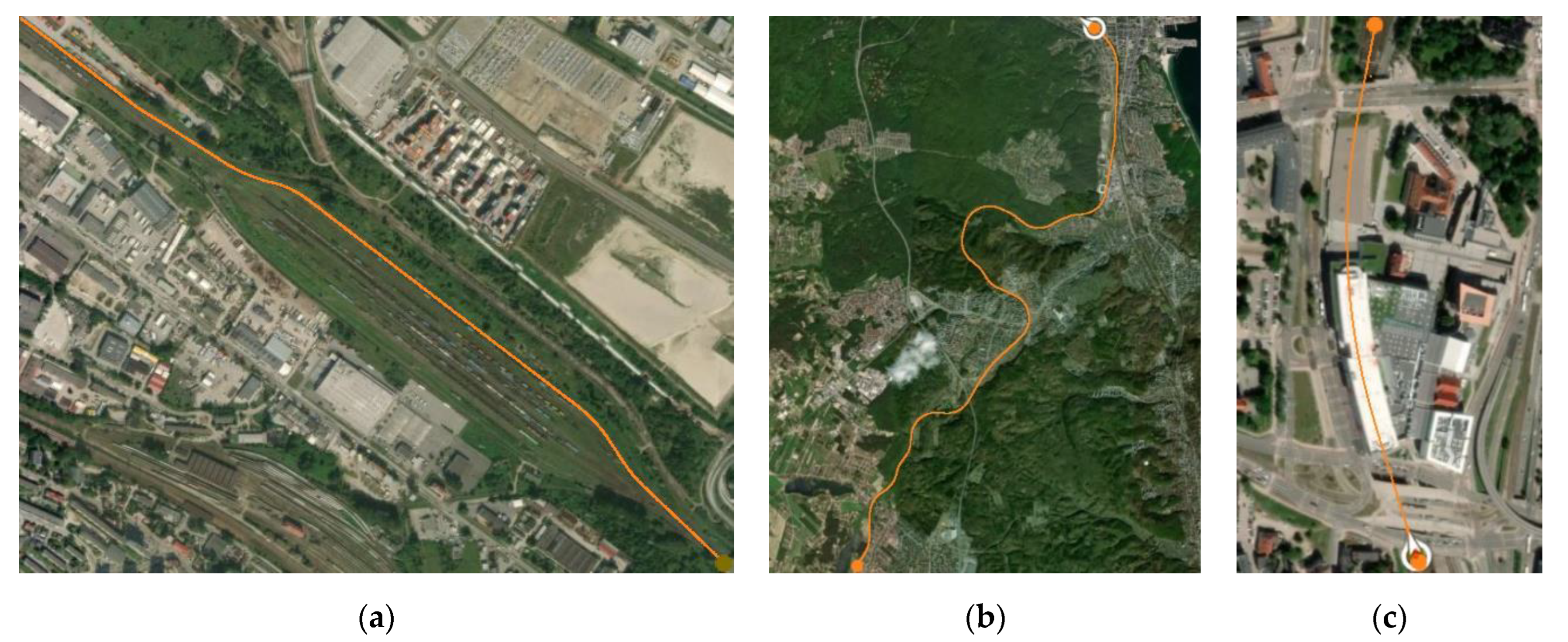

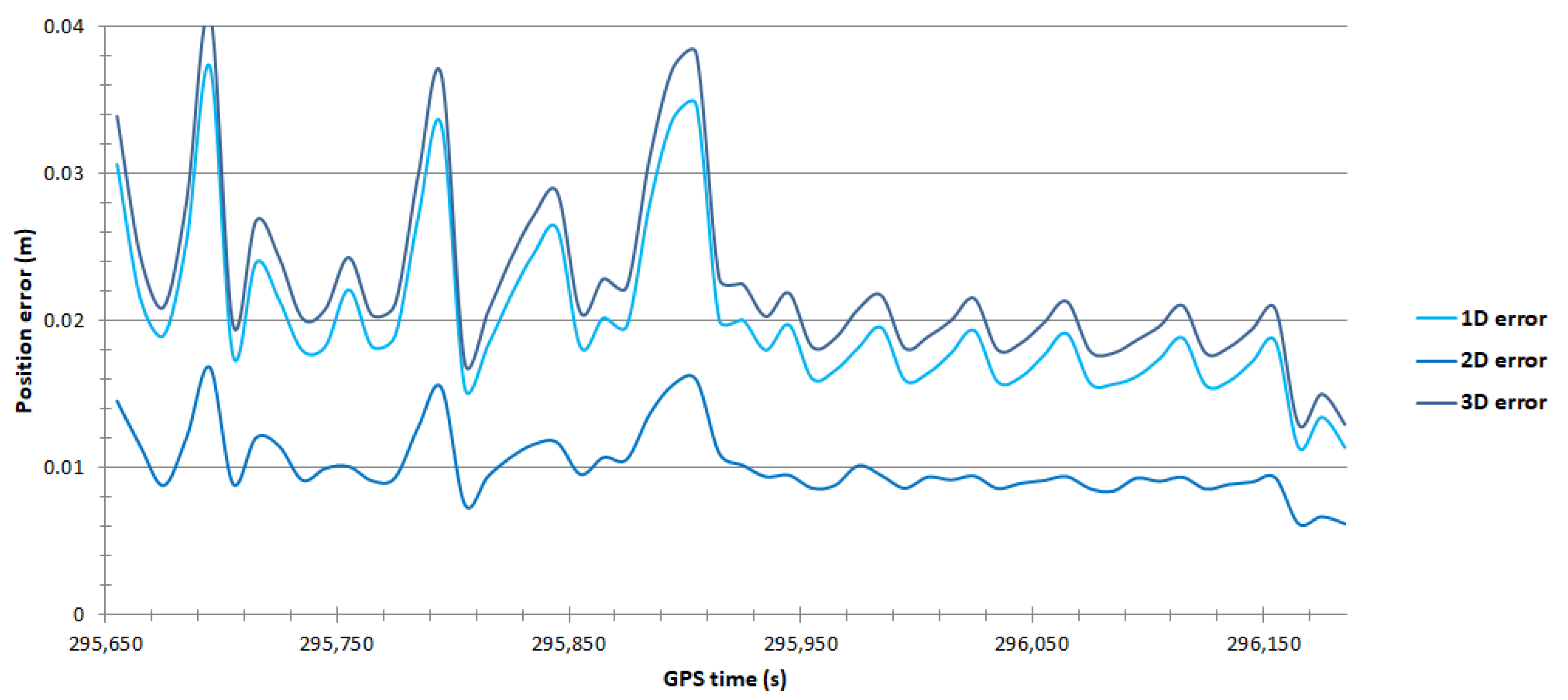
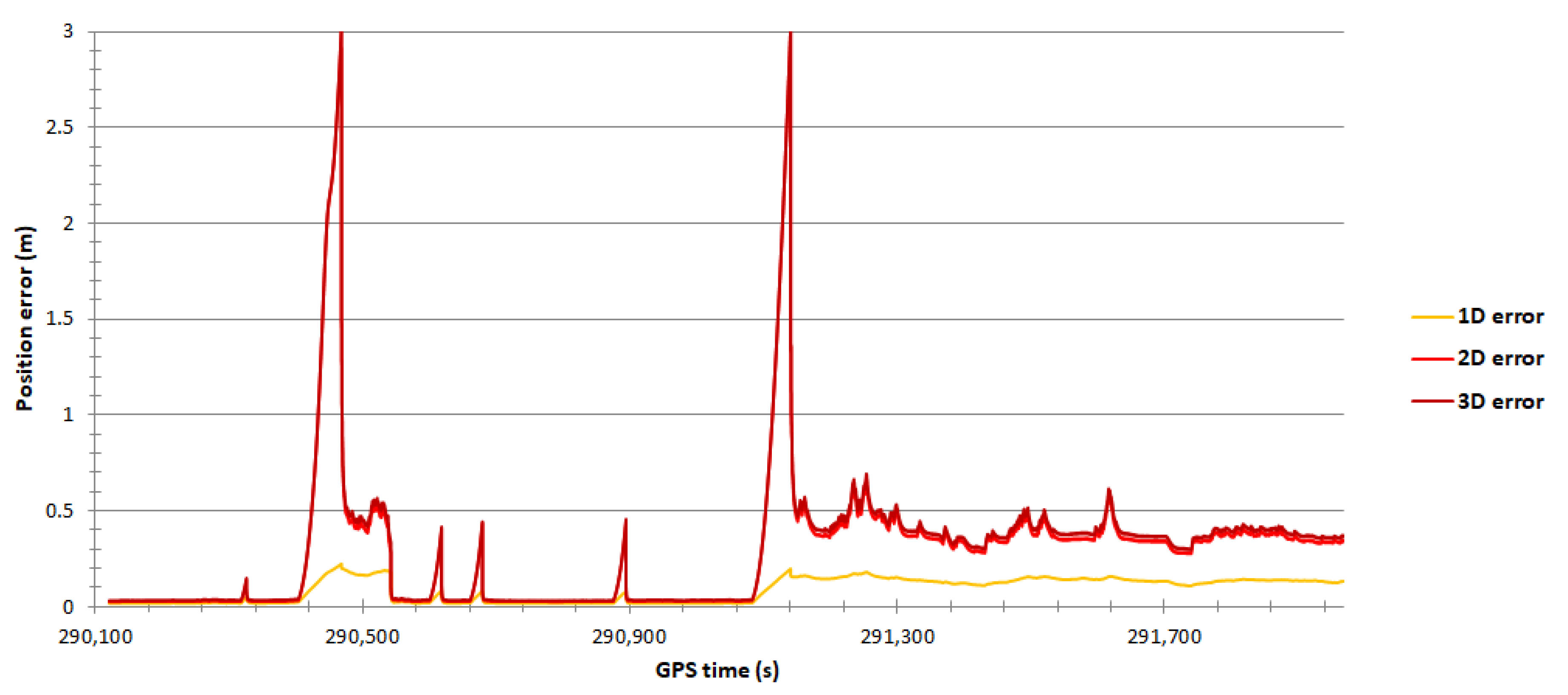
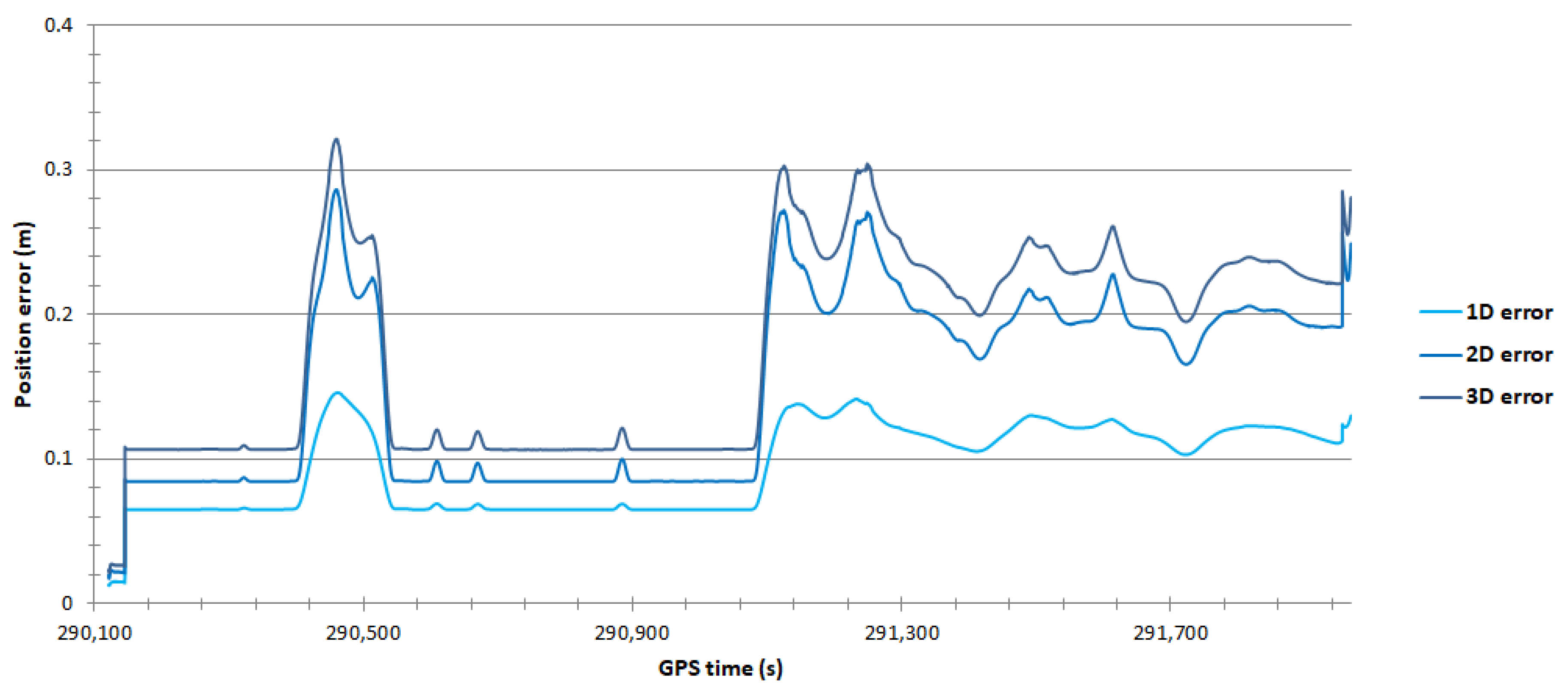
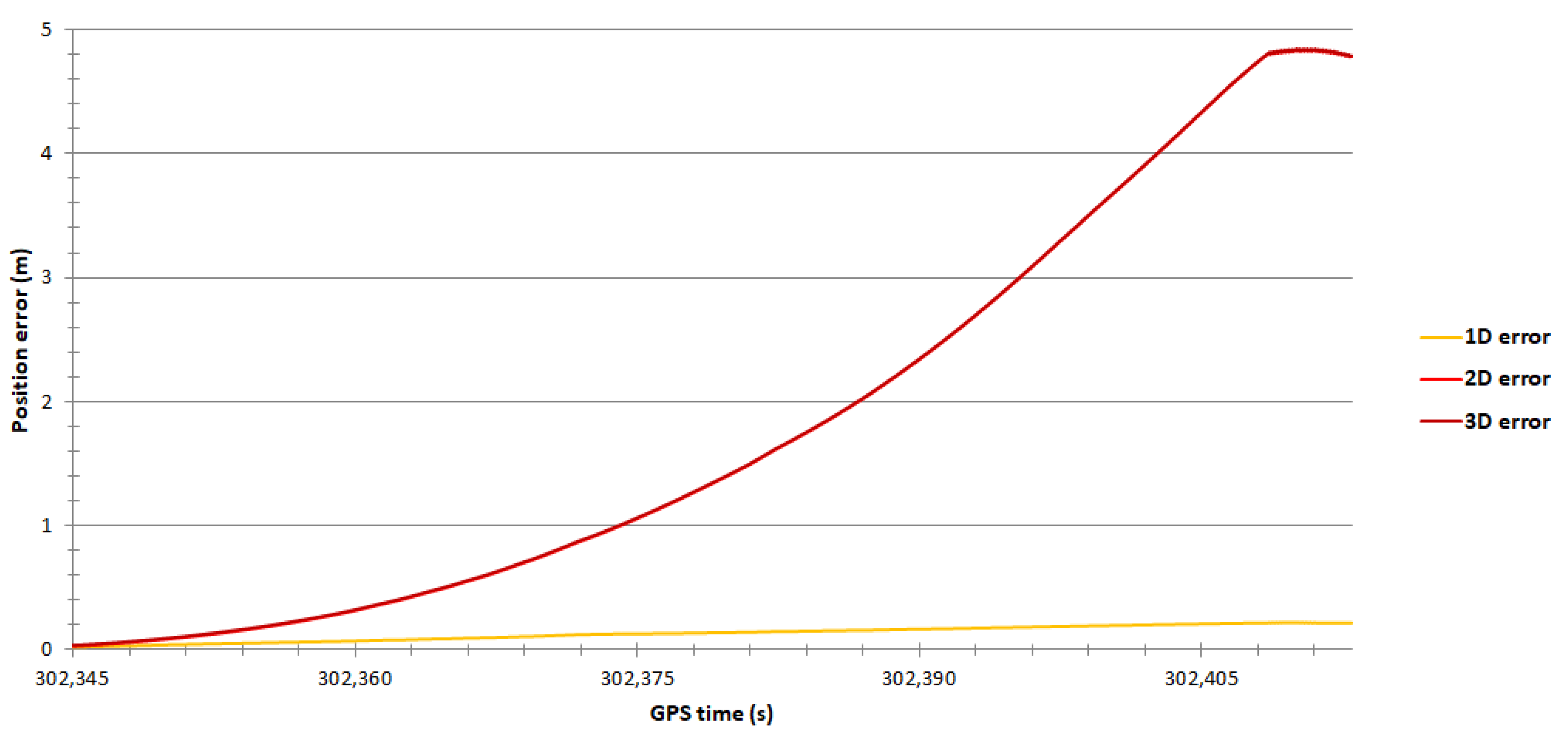
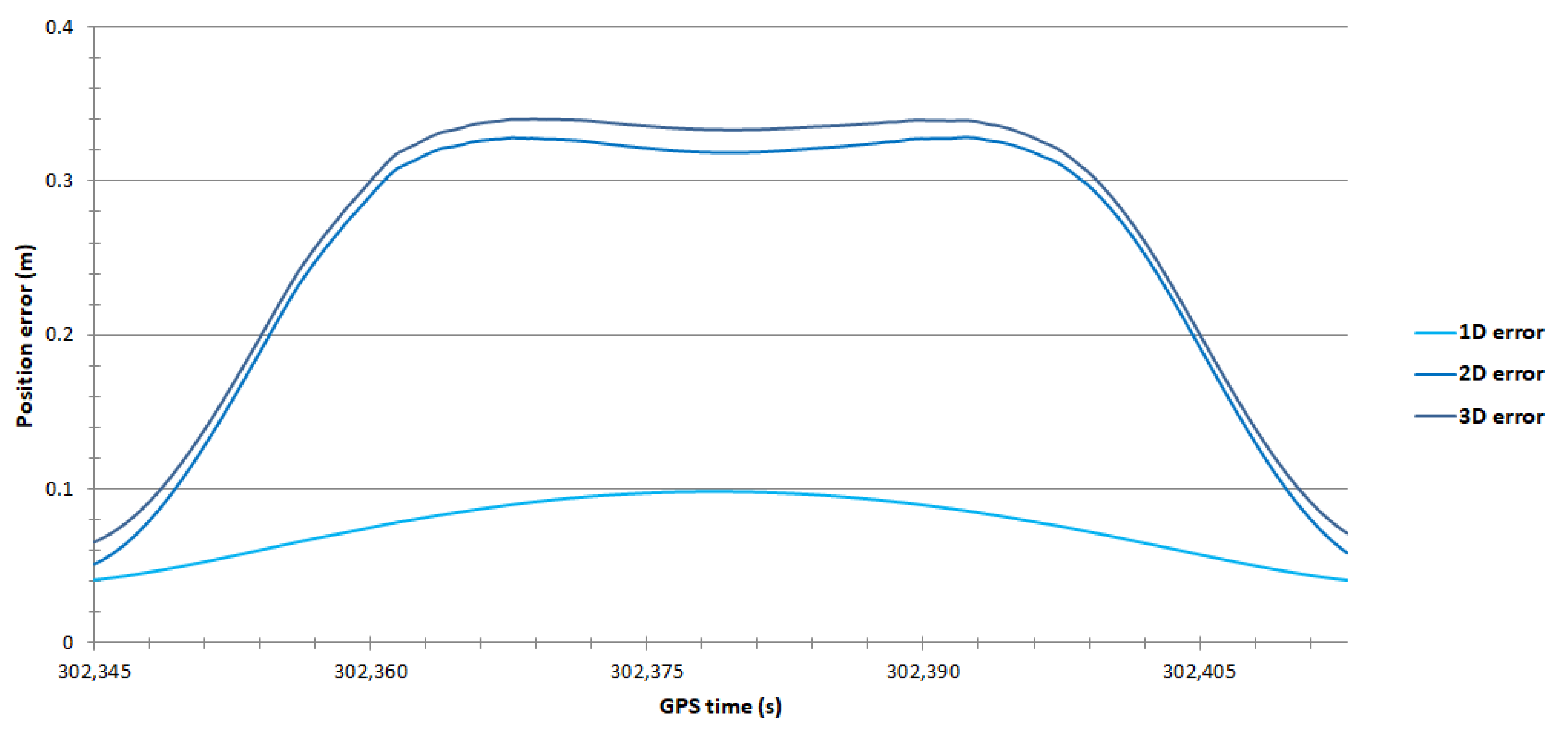
| RMSE | Time That Has Elapsed Since the GNSS Signal Was Not Available | |||||
|---|---|---|---|---|---|---|
| 0 s | 10 s | 30 s | ||||
| RTK | PP | RTK | PP | RTK | PP | |
| 2D position (m) | 0.010 | 0.010 | 0.350 | 0.030 | 4.000 | 1.500 |
| Height (m) | 0.020 | 0.020 | 0.150 | 0.030 | 0.500 | 0.500 |
| Pitch, roll (°) | 0.050 | 0.020 | 0.100 | 0.020 | 0.150 | 0.040 |
| Course (°) | 0.050 | 0.040 | 0.100 | 0.050 | 0.150 | 0.070 |
| Statistics of Position Error | Type of Processing Data | Type of Registered Data | |
|---|---|---|---|
| RTK | PP | ||
| Number of measurements | 108,401 | 542 | 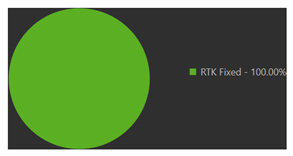 |
| RMS(ϕ) | 0.019 m | 0.007 m | |
| RMS(λ) | 0.019 m | 0.005 m | |
| RMS(h) | 0.019 m | 0.017 m | |
| DRMS(2D) | 0.027 m | 0.009 m | |
| 2DRMS(2D) | 0.054 m | 0.018 m | |
| DRMS(3D) | 0.033 m | 0.020 m | |
| CEP(2D) | 0.027 m | 0.007 m | |
| R68(2D) | 0.027 m | 0.005 m | |
| R95(2D) | 0.028 m | 0.017 m | |
| SEP(3D) | 0.033 m | 0.009 m | |
| R68(3D) | 0.033 m | 0.018 m | |
| R95(3D) | 0.035 m | 0.020 m | |
| Statistics of Position Error | Type of Processing Data | Type of Registered Data | |
|---|---|---|---|
| RTK | PP | ||
| Number of measurements | 369,401 | 369,401 |  |
| RMS(ϕ) | 0.408 m | 0.122 m | |
| RMS(λ) | 0.254 m | 0.109 m | |
| RMS(h) | 0.107 m | 0.099 m | |
| DRMS(2D) | 0.481 m | 0.163 m | |
| 2DRMS(2D) | 0.961 m | 0.326 m | |
| DRMS(3D) | 0.492 m | 0.191 m | |
| CEP(2D) | 0.324 m | 0.175 m | |
| R68(2D) | 0.364 m | 0.197 m | |
| R95(2D) | 0.600 m | 0.246 m | |
| SEP(3D) | 0.345 m | 0.204 m | |
| R68(3D) | 0.388 m | 0.231 m | |
| R95(3D) | 0.621 m | 0.279 m | |
| Statistics of Position Error | Type of Processing Data | Type of Registered Data | |||
|---|---|---|---|---|---|
| First Trip | Second Trip | ||||
| RTK | PP | RTK | PP | ||
| Number of measurements | 15,001 | 15,001 | 13,601 | 13,601 | 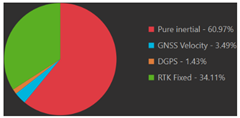 1st travel 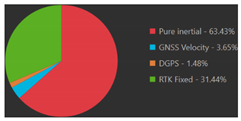 2nd travel |
| RMS(ϕ) | 2.904 m | 0.305 m | 2.376 m | 0.236 m | |
| RMS(λ) | 0.389 m | 0.303 m | 0.431 m | 0.134 m | |
| RMS(h) | 0.167 m | 0.109 m | 0.143 m | 0.078 m | |
| DRMS(2D) | 2.930 m | 0.430 m | 2.415 m | 0.271 m | |
| 2DRMS(2D) | 5.860 m | 0.859 m | 4.829 m | 0.543 m | |
| DRMS(3D) | 2.935 m | 0.443 m | 2.419 m | 0.282 m | |
| CEP(2D) | 1.577 m | 0.398 m | 1.340 m | 0.315 m | |
| R68(2D) | 2.991 m | 0.534 m | 2.482 m | 0.322 m | |
| R95(2D) | 5.886 m | 0.640 m | 4.811 m | 0.328 m | |
| SEP(3D) | 1.584 m | 0.413 m | 1.347 m | 0.325 m | |
| R68(3D) | 2.998 m | 0.548 m | 2.487 m | 0.335 m | |
| R95(3D) | 5.891 m | 0.655 m | 4.816 m | 0.340 m | |
Publisher’s Note: MDPI stays neutral with regard to jurisdictional claims in published maps and institutional affiliations. |
© 2022 by the authors. Licensee MDPI, Basel, Switzerland. This article is an open access article distributed under the terms and conditions of the Creative Commons Attribution (CC BY) license (https://creativecommons.org/licenses/by/4.0/).
Share and Cite
Specht, M.; Specht, C.; Stateczny, A.; Burdziakowski, P.; Dąbrowski, P.; Lewicka, O. Study on the Positioning Accuracy of the GNSS/INS System Supported by the RTK Receiver for Railway Measurements. Energies 2022, 15, 4094. https://doi.org/10.3390/en15114094
Specht M, Specht C, Stateczny A, Burdziakowski P, Dąbrowski P, Lewicka O. Study on the Positioning Accuracy of the GNSS/INS System Supported by the RTK Receiver for Railway Measurements. Energies. 2022; 15(11):4094. https://doi.org/10.3390/en15114094
Chicago/Turabian StyleSpecht, Mariusz, Cezary Specht, Andrzej Stateczny, Paweł Burdziakowski, Paweł Dąbrowski, and Oktawia Lewicka. 2022. "Study on the Positioning Accuracy of the GNSS/INS System Supported by the RTK Receiver for Railway Measurements" Energies 15, no. 11: 4094. https://doi.org/10.3390/en15114094








